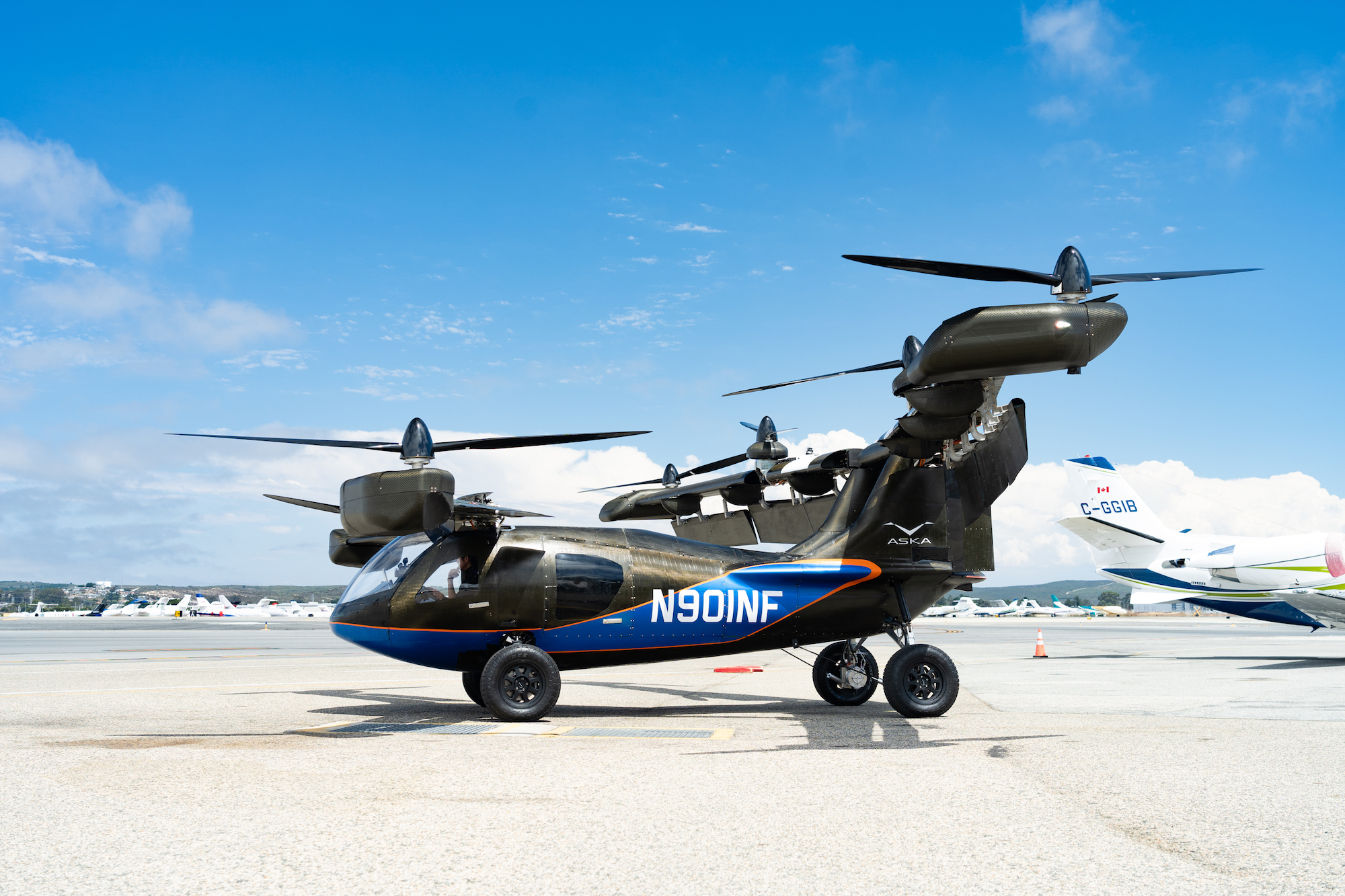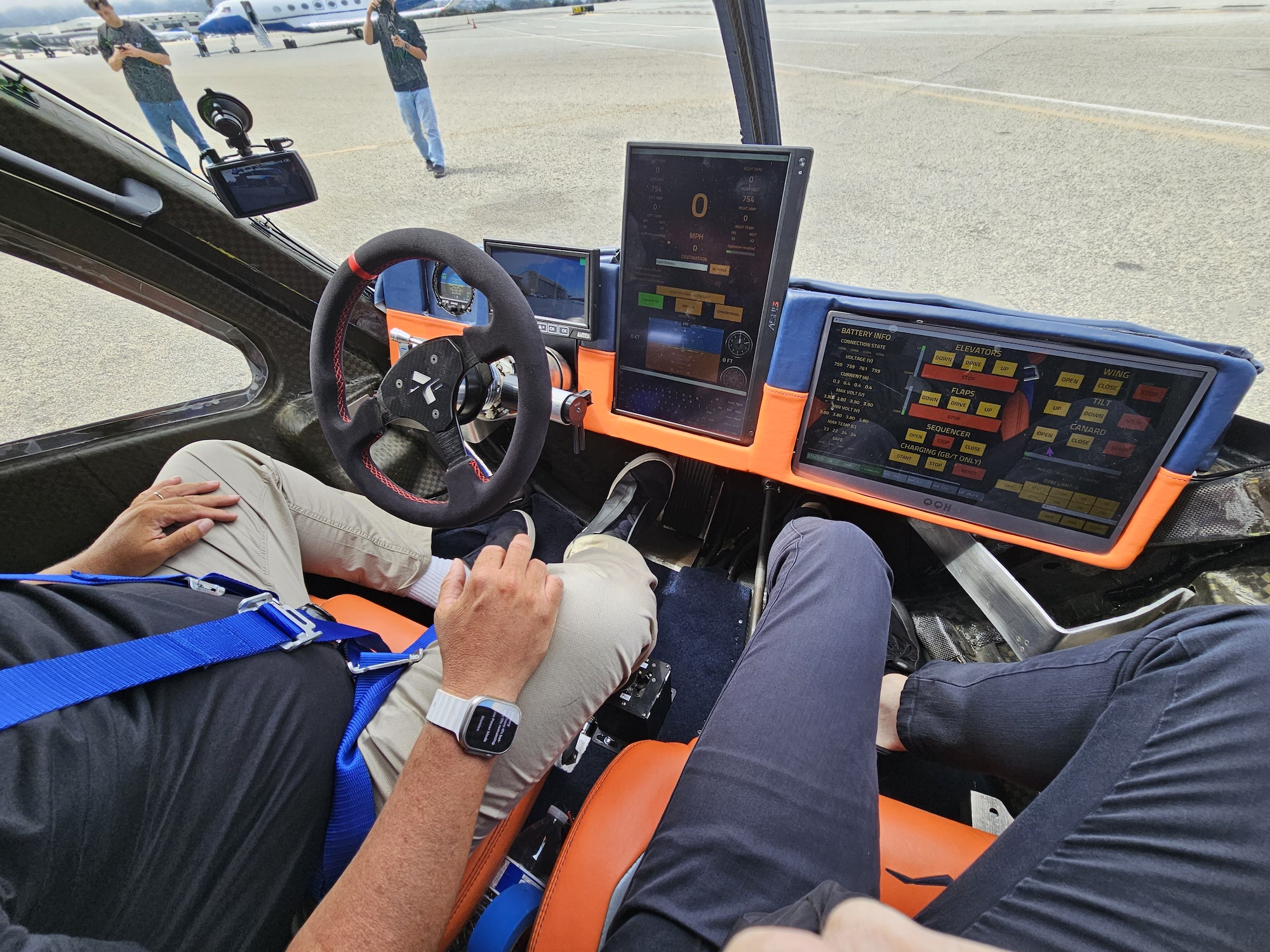I don’t know what I expected the ASKA A5 to look like in person, but the machine lurking in a parking lot just outside of Monterey Regional Airport wasn’t it. Like a cross between a piece of commercial farm equipment and a contraption from G.I. Joe’s nemesis Cobra, the A5 makes a curious first impression.
At a minimum, it’s less flying car and more drivable aircraft, and believe it or not that’s an important distinction.
I got taken for a quick spin in the A5 across the taxiway at Monterey Regional Airport ahead of the Pebble Beach Concours. It was one of the airport’s busiest days of the year, with high-flying VIPs touching down every few minutes in a near-endless string of private jets. The road-legal prototype A5 looked admittedly awkward amid the rows of Gulfstreams and Learjets.
Legal on the road, and newly legal to take to the skies — in limited fashion, at least.
The electric vertical take-off and landing (eVTOL) A5 is ASKA’s first product, which received a Certificate of Authorization and Special Airworthiness Certification from the Federal Aviation Administration in June ahead of making its first pilotless test flights just weeks ago. The craft was piloted under remote control.
“We don’t need to risk people for our testing,” CEO Guy Kaplinsky said in a recent interview. “We can run it for hundreds or thousands of hours, find all the issues, fix those and then put a pilot here.”
These first, tethered hover flights are just the beginning. A5 will need plenty of testing before it’s allowed to move forward to a full FAA certification allowing for broader flights. Once completed, ASKA will qualify for FAA Type Certification, stating the A5 meets all federal regulations, and then Production Certification, which verifies that ASKA can reliably replicate that certified design.
That’s a lot of steps to complete between now and 2026, when ASKA plans to have the A5 in production.
Birth of a startup

Image Credits: Tim Stevens
Guy Kaplinsky founded ASKA in Mountain View, California with wife Maki in 2018 after selling his previous startup, IQP Corporation, to GE. For their new project, the goal was to move the needle on personal transportation in a way that didn’t require major infrastructure changes.
“I wanted to do something different than just another software company,” he told me as we stood next to the A5 on a windy taxiway outside of the airport. Guy and Maki saw transportation as an area ripe for innovation.
“Nothing has been developed in the last 100 years. The cars we have today, going from point A to point B, they take the same time. They’re electric, they’re cleaner, it’s great, but at the end of the day it’s the same time,” he said. “And public transportation is not really being developed, because of the cost of building.”
Kaplinsky says that the governments haven’t made any major transportation infrastructure changes since the 1980s. “Whenever the government has to invest in infrastructure you know it’s not going to work, because there’s no money to invest,” he said.
If you want to radically improve transportation without building new roads and bridges, that means one of two things: going up or going down. The Boring Company’s inability to solve even Las Vegas traffic seemingly points toward the air as a better solution. And so, like Joby Aviation and Archer Aviation, ASKA ( which means “flying bird” in Japanese) is aiming high.
In addition to vertical takeoffs, the A5’s reconfigurable wings and motors mean it can also take off or land on a runway like a traditional aircraft, or do a sort of hybrid approach for shortened takeoff, relying on the pair of wheel-mounted electric motors to accelerate it up to speed.
The two electric motors that drive the rear wheels, plus six more that spin the wing-mounted propellers, are powered by an onboard battery with a capacity of roughly 100 kWh. The target for maximum flight range is 250 miles, enabled by an onboard, gasoline-powered generator to recharge while in-flight.
Though largely electric, the A5 won’t be silent. “It’s going to have much less noise than a helicopter,” Kaplinsky said, “but it will still be noisy.” And that is one of the company’s current challenges.
Kaplinsky envisions the A5, and its eventual successors, for short-hop airborne ride-hailing, carrying commuters from suburb to city then back again, zipping high above the traffic much like Uber had pledged to do with its Elevate project before selling that business to Joby Aviation in 2020.
Uber is something of a target for Kaplinsky, aiming to ultimately offer airborne rides at prices comparable to Uber Black. But, before ASKA can think about the kind of volume that would facilitate those prices, it needs routes, and that means landing an aircraft like this inside densely packed urban areas.
This is where the noise becomes an issue.
Kaplinsky is optimistic that regulations can be relaxed to allow that kind of operation, but autonomous piloting will require even broader changes from the FAA. For that reason, the company’s initial craft will indeed be human piloted.
And where will they land? Kaplinsky says ASKA plans to buy up gas stations once they start going out of business due to the shift toward electrification.
Kaplinsky described the A5 as a last-mile solution, although that term doesn’t quite fit. Where the foldable scooters and mini-motorcycles that crowd the last-mile space are designed to make city travel easy by being a cinch to park or carry, the A5 is described as a last-mile vehicle because it isn’t meant to go far or fast on the ground.
The company says that once the A5 is in the air it can travel 250 miles on a charge. For my test, though, the A5 would stay purely on the tarmac.
Test drive
Climbing up in the flying car is a bit awkward, with the cockpit accessed through a thin and remarkably flimsy door that does little to filter out the constant, earsplitting racket of an active taxiway. There’s seating for two (the production vehicle will seat four), but not much in the way of headroom or legroom. Or any room, for that matter. Nor were there any nods toward visual panache beyond the blue and orange vinyl slapped on the dashboard.
A trio of displays form the bulk of the interface. The portrait touchscreen on the right has buttons to control things like extending and tilting the wings and flaps. In the center, a vertically oriented display shows an artificial horizon plus other metrics about the drive or flight.
Over on the left, behind the pilot’s steering wheel, is the third display, which serves feeds from cameras positioned on the A5’s body. Finally, on the far left is an attitude indicator gauge.
Physical controls are limited to a steering wheel, an accelerator, a brake pedal and a shifter. There are no flight controls yet, again because all piloting is remote for now.
The A5 prototype’s construction is crude, but the ride was pleasant enough. The chassis groaned and the folded wings above creaked over every asphalt imperfection, but no more so than any other hand-built prototype car I’ve been in.
The process of folding out the wings took about two minutes; rear wings lifting and swiveling backward before the shorter front wings folded forward. The six integrated motors can pivot vertically for takeoff and landing then angle forward for flight.
With everything deployed, propellers spinning only in the breeze for now, the transformed A5 was a real head-turner. That formerly awkward contraption looked suddenly ready for business. The question, though, is whether ASKA itself is.
Kaplinsky declined to comment on how much the company has raised, saying only that they’re not following formal funding rounds. “As a startup, we’re always doing raising, always looking for partners who can understand the potential of the defense business,” he said, “for the civil market, for the commercial market.”
ASKA has already performed demonstrations for the U.S. Army, Air Force and Navy at Camp Roberts in Monterey. The hovering tests, meanwhile, are performed at a private airport.
In addition to investors, ASKA is looking for customers. While an Uber-like service is the ultimate goal, well-heeled lovers of curious modes of transportation can get on the list for a personal A5 for $789,000. The company has received 100 preorders, each with $5,000 deposits attached.
















 English (US) ·
English (US) ·